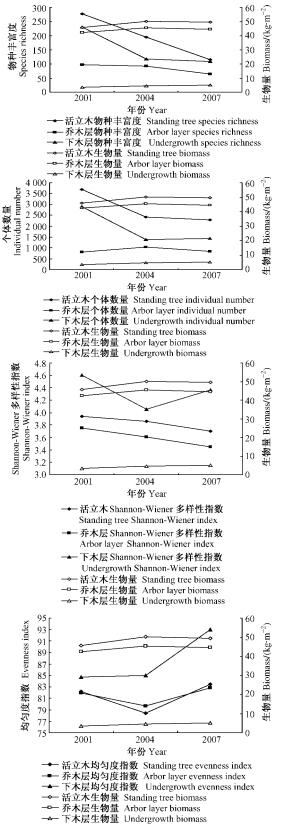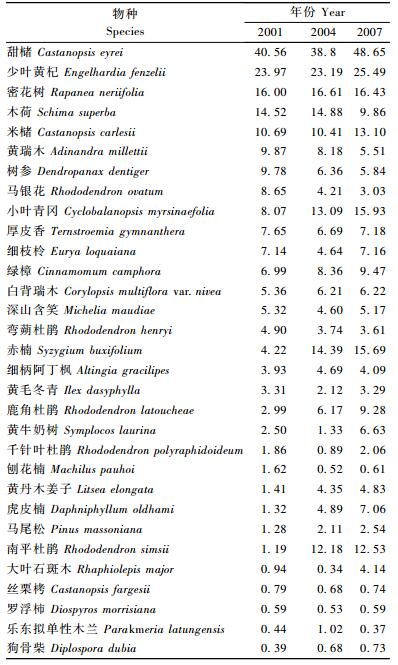文章信息
- 任引, 彭丹, 潘俊忠, 洪志猛, 叶功富
- Ren Yin, Peng Dan, Pan Junzhong, Hong Zhimeng, Ye Gongfu
- 不同时空尺度下武夷山甜槠林物种多样性与生物量的动态关系
- Relationship between Species Biodiversity and Biomass Accumulation in a Castanopsis eyrei Forest in Wuyishan Mountain under Different Temporal and Spatial Scales
- 林业科学, 2010, 46(8): 33-38.
- Scientia Silvae Sinicae, 2010, 46(8): 33-38.
-
文章历史
- 收稿日期:2010-01-03
- 修回日期:2010-06-12
-
作者相关文章
2. 福建省林业调查规划院 福州 350003;
3. 南京林业大学森林资源与环境学院 南京 210037;
4. 福建省林业科学研究院 福州 350012
2. Fujian Forestry Investigating and Planning Institute Fuzhou 350003;
3. College of Forest Resources and Environment, Nanjing Forestry University Nanjing 210037;
4. Fujian Academy of Forestry Fuzhou 350012
物种多样性和生物量是群落生态系统的2个关键变量,生物量是群落生态功能最基本的组成部分,物种多样性则是表征群落结构的重要参数(Guo, 2007)。对于物种多样性与生态系统生物量的关系问题,从20世纪90年代至今一直存在激烈的争论(Gary et al., 2001; Mckie et al., 2008)。全球性的物种多样性降低及生态系统太阳能利用率下降可能对生态系统功能如系统生物量、养分循环和凋落物分解速率等产生影响,已引起生态学家的广泛关注(Loreau et al., 2001; 方燕鸿,2005; 朱源等,2007)。Marriott等(2009)通过对草原生态系统16年的研究仍然无法证明物种多样性降低会导致生产力的下降; Lewis等(2009)认为热带森林生态系统功能对于物种多样性降低的响应是多种多样的。量化物种多样性与生态系统生物量的关系还为时尚早(Bengtsson, 1998; Hector et al., 2007; Peter et al., 2007; Gamfeldt et al., 2008),因为目前的研究还存在以下问题: 1)孤立研究某一尺度下的单个进程(Hector et al 2007); 2)缺少长期动态研究(Gary et al., 2001; Mulder et al., 2001; Hino et al 2009); 3)研究对象单一,目前研究对象多为多年生草原生态系统(Jasper et al., 2005); 4)研究方法简单生态系统经常偏离自然状态,忽略了物种组成和结构发生变化的生态进程(Deng et al., 2008; Gamfeldt et al., 2008)。本研究分析典型甜槠常绿阔叶林样地不同时间和空间尺度物种多样性和生物量的关系,为阐明物种多样性和生态功能的相互作用机制提供理论依据。
1 研究区概况研究区位于福建武夷山国家级自然保护区内(117°41′E,27°42′N)。保护区南北长52 km,东西最宽处22 km,总面积5.65万km2,属于典型中亚热带常绿阔叶林森林生态系统。全区平均海拔1 200 m,主峰黄岗山海拔2 158 m,年均气温17.9 ℃,属中亚热带湿润季风气候区,系我国全球变化敏感带所在地,主要土壤类型为红壤。
甜槠(Castanopsis eyrei)林是武夷山国家级自然保护区最常见的群落类型,其分布广,面积大。群落外貌呈深绿色,群落总盖度85%~95%,群落密度为3 208株·hm-2,平均树高8.5 m,平均胸径12.19 cm,林龄50年。成熟天然林林下植物种类单调,草本层稀疏。该森林类型分布于海拔500~1 200 m。一般生长在山坡的中部偏上,土壤多为坡积土,土层较厚。甜槠林主要的优势树种包括少叶黄杞(Engelhardtia fenzelii)和密花树(Rapanea neriifolia); 亚优势树种包括木荷(Schima superba)、米槠(Castanopsis carlesii)、黄瑞木(Adinandra millettii)、树参(Dendropanax dentiger)和赤楠(Syzygium buxifolium)。甜槠一般为建群种,有时也与其他乔木组成共优势群落。
2 研究方法2001年11月,选择甜槠优势群落集中分布区域,设置1块9 600 m2样地,再将样地划分为24块20 m× 20 m的样地,每个400 m2样地的4个角上分别设1个2 m× 2 m的灌木样方。
分别于2001年11月、2004年11月和2007年11月对24块400 m2样地的乔木层(胸径≥2.5 cm)进行每木检尺,分别记录树高、胸径和冠幅; 对下木层记录各样方内所有植物的种名、高度、个体数和覆盖度。
重要值Ⅳ为相对密度、相对显著度和相对频度3者之和乘100比3。
采用丰富度指数、Shannon-Wiener指数、Simpson指数和Pielou均匀度指数来测定群落物种多样性(宋永昌,2001)。
乔木层生物量的测定:由于本研究区的环境条件和群落特征与南亚热带常绿阔叶林近似,因此9 600 m2样地和400 m2样地均采用张咏梅等(2006)的生物量回归方程(r=0.959~0.997)推算生物量。同时,根据样地每木调查资料计算出全部立木的平均胸高断面积,采用平均木法选出最接近于这个平均值的3株标准木,伐倒后求出单株平均木的生物量,再乘以该林分单位面积上的株数,得到单位面积上林分乔木层的生物量, 经验证推算法证明, 生物量的准确性达到93.77%(林益明等,2001)。
下木层生物量的测定:采用收割法直接称每个样方灌木和草本的鲜质量,混合96个4 m×4 m样方样品,然后带回实验室在80 ℃下烘干至恒质量,求出干鲜质量比,将每个样方中下木鲜质量按干鲜质量之比换算成干质量,累积相加得到样方面积的下木生物量,再换算成单位面积的下木层生物量。
凋落物生物量的测定:在每个400 m2样地设置10个口径为1 m×1 m的收集框,距地面20 cm; 收集网为孔径2 mm的玻璃纤维网。凋落物收集测定时间为2001-11—2007-11,每15天收集1次,并分出叶、大枝(直径>5 mm)、小枝(直径≤5 mm)、花(包括花序)和果(包括果序)。及时测定其鲜质量,然后于各组分中抽部分样品在105 ℃烘干至恒质量,测其含水量,推算每月凋落物的总干质量。
粗木质残体生物量的测定:分别于2001年11月、2004年11月和2007年11月对9 600 m2样方内枯立木和倒木进行每木调查,并编号、标明树种,逐株登记其高度和胸径,采用生物量回归方程(张咏梅等,2003)推算单位面积的生物量。采用烘干法求得单位面积大枝条和根桩的生物量。
利用SPSS 12.0软件对多样性指标和生物量分别进行自相关分析和双尾检验。
3 结果与分析 3.1 不同空间尺度下的群落物种组成甜槠林9 600 m2样地中的物种数从2001年的51科88属223种下降到2007年的29科56属116种, 其中,乔木层减少28种,下木层减少121种。优势种重要值有所增加,排序不变,亚优势种重要值和排序均发生变化:甜槠重要值由2001年的40.56增加到2007年的48.65,排序不变; 木荷重要值由2001年的14.52下降到2007年的9.86,排序后退4位(表 1)。
|
|
甜槠林400 m2样地群落物种丰富度均值从2001年的49.33±10.93种下降到2007年的42.88±10.42种,其中,乔木层下降1.33±0.43种,下木层下降8.33±0.60种; 24个400 m2样地中只有3个样地2007年下木层和整个群落的物种丰富度相比于2001年是增加的(表 2); 5个样地优势种排序发生变化,优势种重要值平均增加5.46±1.94, 甜槠重要值增加8.47±1.88。
|
|
伴随甜槠林9 600 m2样地中物种丰富度的下降和优势种重要值的增加,群落总生物量和枯落物(包括凋落物和粗木质残体)生物量呈逐年增加的趋势,而活立木(包括乔木层和下木层)生物量呈先上升后下降的趋势(图 1)。

|
图 1 群落总生物量与物种丰富度动态关系 Figure 1 Dynamic relationship between species richness and total community biomass |
2001—2004和2004—2007年,9 600 m2样地最主要的30个物种群落总生物量变量与重要值变量之间分别呈现多项式和线性关系(图 2)。2001—2004年重要值变量的标准差为4.022 5,大于2004—2007年的标准差(2.526 2)。

|
图 2 9 600 m2样地不同时间段生物量变量和重要值变量的关系 Figure 2 Relationship between important value variation and biomass variation within a 9 600 m2 plot in different years |
从图 3可以看出,随着9 600 m2样地生物量的增加,群落总体、乔木层和下木层的多样性指标变化趋势不同。物种丰富度在群落总体、乔木层和下木层均表现为下降趋势; 而均匀度指数在群落总体和乔木层表现为先下降后增加趋势,在下木层表现为增加趋势。

|
图 3 2001—2007年9 600 m2样地多样性指标和总生物量关系 Figure 3 Relationships between diversity indexes and total biomass within the 9 600 m2 plot from 2001 to 2007 |
和9 600 m2样地群落总生物量变化趋势相似,24个400 m2样地的平均生物量从2001年的(66.46±4.91) kg·m-2分别增加到2004年的(74.82±5.67) kg· m-2和2007年的(78.62±5.71) kg· m-2。相同时间进程400 m2样地间生物量增加量差异显著(P < 0.01)。
400 m2样地物种多样性指标与活立木生物量在2001—2004和2004—2007年的关系如图 4所示。不同层次不同时间进程表现出明显的异质性: 2001—2004年,随着活立木生物量增加,下木层Shannon-Wiener指数和物种丰富度明显下降; 2004—2007年,乔木层Shannon-Wiener指数和物种丰富度明显下降(图 4)。此外,物种多样性各指标与活立木生物量间均不存在显著相关性(P>0.05)。

|
图 4 2001—2007年400 m2样地多样性指标和生物量的关系 Figure 4 Relationships between diversity indexes and biomass within 400 m2 plots in different years |
随着演替进展,9 600 m2样地生物量增加,物种丰富度在群落总体、乔木层和下木层均表现为下降趋势; 个体数量在群落总体表现为下降趋势,在乔木层表现为先增加后下降的趋势,在下木层表现为先下降后增加的趋势; Shannon-Wiener指数在群落总体和乔木层均表现为下降趋势,在下木层表现为先下降后增加的趋势; 均匀度指数在群落总体、乔木层和下木层均表现为先下降后增加的趋势。400 m2样地物种多样性各指标在不同层次不同时间进程中表现出更明显的异质性,2001—2004年,随着活立木生物量的增加,下木层Shannon-Wiener指数和物种丰富度明显下降; 2004—2007年,乔木层Shannon-Wiener指数和物种丰富度明显下降。此外,物种多样性各指标与活立木生物量间均不存在显著相关性(P>0.05)。说明物种多样性对生态系统功能的影响在不同的时空尺度中差异明显。
本研究首次在中亚热带常绿阔叶林研究物种多样性与生物量的动态关系。目前国内外在该领域的研究对象主要集中于多年生草原生态系统,而且研究时间只持续2个生长季节,相比于草原生态系统,森林生态系统有着更丰富的物候变化、物种组成和遗传特性(Jasper et al., 2005)。此外,本研究在不同群落层次结构(包括群落总体、乔木层和下木层)和空间尺度(9 600 m2样地和400 m2样地),分成不同时间段(2001—2004年和2004—2007年),采用4种物种多样性测度指标(物种丰富度、个体数量、Shannon-Wiener指数和均匀度指数)研究物种多样性与生物量的动态关系,而国内外的相关研究往往只关注某一尺度下的单个进程。
本研究是在相对较小的样地尺度展开的,各种干扰及环境因素变化对其的影响被控制在最小范围内。当观测尺度扩大时,物种多样性及生物量将受到各种因素的影响,可能发现不同的结果。因为大型研究样地的环境异质性是巨大的,如果试验设计与土壤、气象数据作为共同使用变量进行数据分析,可能隐藏了相互关系的潜在机理(Christoph et al., 2009)。因此,在综合考虑各种影响因素的基础上,在更大的空间尺度下研究物种多样性和生物量的动态关系,对于完整地理解物种多样性的功能意义更为重要(Bradley et al., 2002)。
方燕鸿. 2005. 武夷山米槠、甜槠常绿阔叶林的物种组成及多样性分析[J]. 生物多样性, 13(2): 148-155. |
林益明, 杨志伟, 李振基. 2001. 武夷山常绿林研究[M]. 厦门: 厦门大学出版社.
|
宋永昌. 2001. 植被生态学[M]. 上海: 华东师范大学出版社.
|
张咏梅, 周国逸, 温达志, 等. 2003. 南亚热带季风常绿阔叶林锥栗-荷木-黄果厚壳桂群落发展趋势探讨[J]. 植物生态学报, 27(2): 256-262. DOI:10.17521/cjpe.2003.0039 |
朱源, 康慕谊, 刘全儒, 等. 2007. 贺兰山高山草甸生物多样性和地上生物量的关系[J]. 应用与环境生物学报, 13(6): 771-776. |
Bengtsson J. 1998. Which species? What kind of diversity? Which ecosystem function? Some problems in studies of relations between biodiversity and ecosystem function[J]. Applied Soil Ecology, 10(2): 191-199. |
Bradley J C, Margaret A P, Scott L C. 2002. Species diversity enhances ecosystem functioning through interspecific facilitation[J]. Nature, 415(3): 426-429. |
Christoph L, Hermann F J, Stefan F. 2009. Functional role of forest diversity: pros and cons of synthetic stands and across-site comparisons in established forests[J]. Basic and Applied Ecology, 10(1): 1-9. DOI:10.1016/j.baae.2008.06.001 |
Deng F Y, Zang R G, Chen B P. 2008. Identification of functional groups in an old-growth tropicalmontane rain forest on Hainan Island, China[J]. Forest Ecology and Management, 255(3): 1820-1830. |
Gamfeldt L, Hillebrand H, Jonsson P R. 2008. Multiple functions increase the importance of biodiversity for overall ecosystem functioning[J]. Ecology, 89(2): 1223-1231. |
Gary G M, Christopher F S, Samuel M S, et al. 2001. What is the observed relationship between species richness and productivity[J]. Ecology, 82(2): 2381-2396. |
Guo Q F. 2007. The diversity-biomass-productivity relationships in grassland management and restoration[J]. Basic and Applied Ecology, 8(3): 199-208. DOI:10.1016/j.baae.2006.02.005 |
Hector A, Robert B. 2007. Biodiversity and ecosystem multifunctionality[J]. Nature, 448(1): 188-191. |
Hino T, Tsutom H. 2009. Effects of disturbance history and environmental factors on the diversity and productivity of understory vegetation in a cool-temperate forest in Japan[J]. Forest Ecology and Management, 257(3): 843-857. DOI:10.1016/j.foreco.2008.10.020 |
Jasper V R, Frank B. 2005. Diversity-productivity relationships: initial effects, long-term patterns, and underlying mechanisms[J]. Proceedings of the National Academy of Sciences, 102(2): 695-700. |
Lewis O T. 2009. Biodiversity change and ecosystem function in tropical forests[J]. Basic and Applied Ecology, 10(2): 97-102. DOI:10.1016/j.baae.2008.08.010 |
Loreau M, Naeem S, Inchausti P, et al. 2001. Biodiversity and ecosystem functioning: current knowledge and future challenges[J]. Science, 294(3): 804-808. |
Marriott C A, Hood K, Fisher J M, et al. 2009. Long-term impacts of extensive grazing and abandonment on the species composition, richness, diversity and productivity of agricultural grassland[J]. Agriculture, Ecosystems and Environment, 4(1): 1-11. |
Mckie B G, Woodward G, Hladyz S, et al. 2008. Ecosystem functioning in stream assemblages from different regions: contrasting responses to variation in detritivore richness[J]. Journal of Animal Ecology, 77(3): 495-504. DOI:10.1111/j.1365-2656.2008.01357.x |
Mulder C P H, Uliassi D D, Doak D F. 2001. Physical stress and diversity-productivity relationships: the role of positive interactions[J]. Proceedings of the National Academy of Sciences, 98(3): 6704-6708. |
Peter D E, David L, Mila B. 2007. Tree species diversity and ecosystem function: can tropical multi-species plantations generate greater productivity[J]. Forest Ecology and Management, 233(5): 205-210. |
 2010, Vol. 46
2010, Vol. 46


